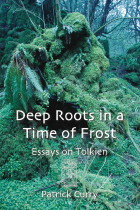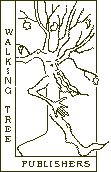Deep Roots in a Time of Frost
Essays on Tolkien
Patrick Curry
Cormarë Series No. 33

<--previous | all publications | next-->
how to buy this item
 In this collection of his published essays, Patrick Curry
explores two themes in Tolkien's great work: enchantment,
the Elves and Faërie, and the natural world of Middle-earth. He
considers their different effects on both readers and literary
critics, and brings to light the deep connections between
these two subjects, as well as between them and Tolkien's
ultimate concern, 'Death and the desire for deathlessness.'
Also illuminated, in contrast, is magic, as epitomised by the
One Ring. Finally, he argues that the hobbits are exemplars
of how to live in relation to enchantment: neither pursuing,
nor avoiding, but honouring it.
In this collection of his published essays, Patrick Curry
explores two themes in Tolkien's great work: enchantment,
the Elves and Faërie, and the natural world of Middle-earth. He
considers their different effects on both readers and literary
critics, and brings to light the deep connections between
these two subjects, as well as between them and Tolkien's
ultimate concern, 'Death and the desire for deathlessness.'
Also illuminated, in contrast, is magic, as epitomised by the
One Ring. Finally, he argues that the hobbits are exemplars
of how to live in relation to enchantment: neither pursuing,
nor avoiding, but honouring it.
table of contents | abstracts | opinions | announcements | more

Introduction
Part I: Nature
Essay 1
"Less Noise and More Green": Tolkien's Ideology for England
11 (abstract)
Essay 2
Modernity in Middle-earth
43
Essay 3
Middle-earth
49
Essay 4
Review of Ents, Elves, and Eriador
55
Part II: Enchantment
Essay 5
Magic vs. Enchantment
65 (abstract)
Essay 6
Enchantment in Tolkien and Middle-earth
83 (abstract)
Essay 7
Iron Crown, Iron Cage: Tolkien and Weber on
Modernity and Enchantment
95 (abstract)
Essay 8
The Third Road: Faërie in Hypermodernity
105 (abstract)
Part III: Criticism
Essay 9
Tolkien and his Critics: a Critique
125 (abstract)
Essay 10
On Reading Tolkien
191 (abstract)
Essay 11
The Critical Response to Tolkien's Fiction
197 (abstract)
Essay 12
Review of Reading 'The Lord of the Rings'
227
Part IV: Varia
Essay 13
Approaches to Myth in Middle-earth
235 (abstract)
Essay 14
On Hobbits & Elves: or, Took and Baggins Again
245
Index
251
table of contents | abstracts | opinions | announcements | more

If Tolkien were alive today, he would, I believe, endorse Patrick Curry above all others as the critic closest to the secret of enchantment: the primal desire of imagined wonder, that trace-element missing (as Curry shows repeatedly) in the assumptions and ideology of Tolkien's modernist critics, the heart of his own universal appeal.
Tom Shippey
This collection of Patrick Curry's essays and reviews on Tolkien spans some three decades plus (1992 to 2014), and focuses chiefly on Curry's defense of Tolkienian enchantment against its modernist and post-modernist critics. It belongs on the shelf with those scholarly works on Tolkien that seek to situate his work within a larger context of contemporary and current critical attitudes.
Verlyn Flieger
Patrick Curry's work has been central in establishing eco-critical readings of Tolkien, but this useful volume is not limited to this approach. The reader will find a collection of essays exploring various aspects of Tolkien's invented world. Curry's breadth of scholarship is impressive.
Dimitra Fimi
table of contents | abstracts | opinions | announcements | more

"Less Noise and More Green": Tolkien's Ideology for England
This essay explores Tolkien's work (especially The Lord of the Rings) in terms of what I identify as his three central concerns, described here as English culture, nature and ethics. I also defend the work against its detractors, especially cultural materialists. I am more concerned with the reception of the work (e.g. its contemporary meanings) than its production.
This paper draws on a distinction made by J.R.R. Tolkien between Magic (an exercise of the will to change something in the world) and Enchantment (the creation of and entering into a secondary world). After elaborating this contrast and some of its consequences, I suggest the creation of a third category, Glamour, and continue with the discussion of contemporary modernist magic, including Weberian "disenchantment", and its counterpart, genuine contemporary re-enchantment.
Enchantment in Tolkien and Middle-earth
This paper begins with a few general remarks about enchantment as a human experience before turning to its importance both in Tolkien's creative life and in his principal public work, The Lord of the Rings. I turn for elucidation to the work of Verlyn Flieger and that of two philosophers, Ronald Hepburn and Jan Zwicky. My intention here is to trace the effects of enchantment - largely as understood and defined by Tolkien himself - in both his creative life and the world of Middle-earth which resulted from it. I shall start by introducing the idea of enchantment itself.
Iron Crown, Iron Cage: Tolkien and Weber on Modernity and Enchantment
This paper uses both a conceptual and a symbolic-mythological hermeneutic analysis of their very different work to compare the attitudes and understandings of J.R.R. Tolkien and Max Weber towards modernity. It points to fundamental commonalities and suggests that both men also counterposed modernity with enchantment. It therefore includes a closer consideration of the nature of such enchantment and the meta-politics of its relationship with modernist magic.
The Third Road: Faërie in Hypermodernity
In this paper I borrow the idea from an old ballad of three roads, one each to Heaven, Hell and Faërie. I contrast the ambiguous or liminal third road with the other two, arguing that in both religious and secular versions, being parts of an official programme, they tend towards disenchantment. Then I consider the work of Tolkien and Lewis, especially how they resolved the contradiction or tension between religion (the two roads) and enchantment (the third), before turning to the strange case of Philip Pullman. I conclude by considering the fate of Faërie in the circumstances of the beginning of the twenty-first century.
Tolkien and his Critics: a Critique
My paper addresses the question of why Tolkien's work is simultaneously so enduringly popular with readers and so abhorrent to literary critics. It locates the answer in what I define as modernity, as a project to which the latter are heavily committed but about which the former are very worried. Both sets of people are responding (in different ways) to the anti-modernism implicit in Tolkien's creation, which – I argue – has been justified by subsequent events, and in the light of which his book has assumed a new and urgent set of "postmodern" meanings. I criticize Tolkien's modernist critics (including literary modernist, Marxist, feminist and psychoanalytic variants) in some detail, as well as sketching out those positive meanings.
"On Reading Tolkien" explores the links between narrative, place and animism, beginning with the way Tolkien's compelling narratives are emplaced and conversely his places are storied. I maintain that that is how our minds and lives work – which can be best thought of as animism – when unconstrained by the demands of modernism, and end by suggesting that in order to do justice to his work, Tolkien scholarship needs to pay more attention to anthropology and the ecohumanities.
The Critical Response to Tolkien's Fiction
As it says on the tin, this essay concerns the critical response to Tolkien's fiction. The main part takes in "Tolkien criticism" – that is, work by critics with no specialised knowledge of Tolkien's work – but "Tolkien studies" by relative experts is also addressed. Responses are tracked in broadly chronological order from the 1950s through to the present before an attempt is made, under the rubric of "modernism", to understand and assess the largely hostile criticism, especially as compared with the overwhelmingly enthusiastic popular response.
Approaches to Myth in Middle-earth
In this paper, I discuss the intellectual resources and their approaches – including both their theories and values – that I have found most useful in understanding myth in Tolkien's work, especially The Lord of the Rings. I am primarily concerned not with his sources, nor even his uses, but rather the mythic resonances that readers find in his literary myth. Those resources are principally the work of Roberto Calasso, Milton Scarborough, Max Horkheimer and Theodor Adorno, and Sean Kane. These are contrasted (favourably) with that of Frederic Jameson. I also distinguish between the myths of Paleolithic/Mesolithic hunter-gatherers and those of Neolithic/ Bronze Age agricultural and increasingly urban origin; both are present in The Lord of the Rings, but the former occupy a particularly important place in the context (or so I argue) of the increasingly pathological effects of "late modernity", of which that book constitutes an implicit critique.
table of contents | abstracts | opinions | announcements | more

Places of previous publication
"Less Noise and More Green": Tolkien's Ideology for England was first published in Patricia Reynolds and Glen GoodKnight (eds). 1995. Proceedings of the J.R.R. Tolkien Centenary Conference 1992. Milton Keynes: The Tolkien Society, 128-36.
Modernity in Middle-earth was first published in Joseph Pearce (ed.). 1999. Tolkien: A Celebration. London: HarperCollins, 34-39
Middle-earth was first published in in Bron R. Taylor (ed.). 2005. The Encyclopedia of Nature and Religion. Vol. 2. London: Thoemmes Continuum, 1092-93.
Review of Ents, Elves, and Eriador was first published in Tolkien Studies 4 (2007) pp. 238-244.
Magic vs. Enchantment was first published in Journal of Contemporary Religion 14.3 (October 1999): 401-12.
Enchantment in Tolkien and Middle-earth was first published in Graham Harvey (ed.). 2013. The Handbook of Animism. Durham: Acumen, 468- 478.
Iron Crown, Iron Cage: Tolkien and Weber on Modernity and Enchantment was first published in Eduardo Segura and Thomas Honegger (eds.). 2007. Myth and Magic: Art According to the Inklings. Zurich and Jena: Walking Tree Publishers, 99-108.
The Third Road: Faërie in Hypermodernity was first published in Graham Harvey (ed.). 2013. The Handbook of Animism. Durham: Acumen, 468-478.
Tolkien and his Critics: a Critique was first published 1999 in Thomas Honegger (ed.). Root and Branch: Approaches towards Understanding Tolkien. Zurich and Berne: Walking Tree Publishers, 81-148; second edition 2005.
On Reading Tolkien: An earlier version is available online at http://www.lotrplaza.com/forum/forum_posts.asp?TID=239887 &,PID=7294565&,title=patrick-curry-on-reading-tolkien (January 11th, 2014).
The Critical Response to Tolkien's Fiction was first published in Stuart D. Lee (ed.). 2014. A Companion to Tolkien. Oxford: Wiley Blackwell, 369-88
Review of Reading 'The Lord of the Rings' was first published in Tolkien Studies 4 (2007) pp. 297-302.
Approaches to Myth in Middle-earth was first published in Maria Kuteeva (ed.). 2000. The Ways of Creative Mythologies. Imagined Worlds and Their Makers. Two volumes. Telford: The Tolkien Society, volume 1: 45-52.
On Hobbits & Elves: or, Took and Baggins Again was first published in Helen Armstrong (ed.). 2001. Digging Potatoes, Growing Trees. Vol. 3. Telford: The Tolkien Society, 48-52.
table of contents | abstracts | opinions | announcements | more

Deep Roots in a Time of Frost reviewed in Beyond Bree (26th April 2017)
Book reviews in Beyond Bree (8th December 2015)
Deep Roots in a Time of Frost published (13th November 2014)
Table of contents of Deep Roots in a Time of Frost (26th October 2014)
New book by Patrick Curry (18th August 2014)
255 pages, Walking Tree Publishers 2014, Cormarë Series No. 33, ISBN: 978-3-905703-33-7.

<--previous | all publications | next-->
how to buy this item

More on Deep Roots in a Time of Frost Essays on Tolkien

terms and conditions
visitors since 06.10.14
last updated 06.10.14
